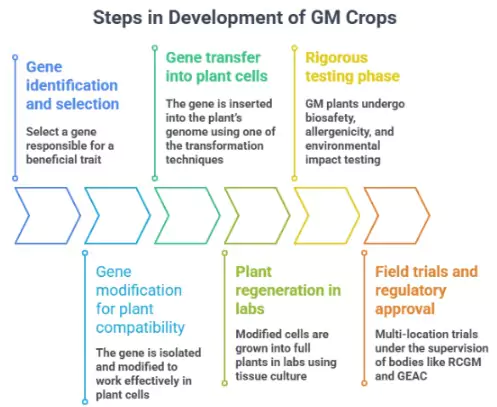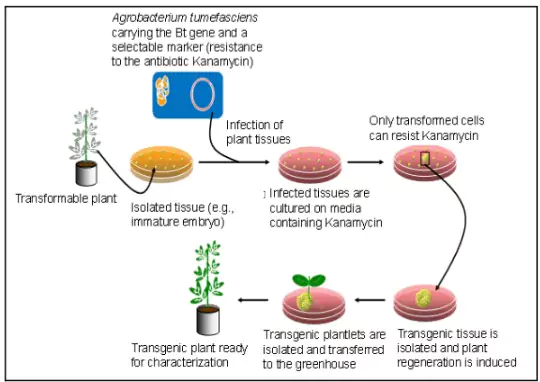As the July 9 deadline approaches, US negotiators are urging India to open its agriculture market to genetically modified (GM) crops.
Agriculture in India
- Agriculture remains the primary livelihood for over 40% of India’s population.
- Contributes about 18% to India’s GDP (as per 2023-24 estimates).
- It is vital for food security, rural employment, and export earnings.
- However, the sector is plagued by:
- Low productivity compared to global standards.
- High vulnerability to climate shocks and pest infestations.
- Input-intensive farming (fertilizer, pesticide) degrading soil and water quality.
- Fragmented landholdings and stagnant technology adoption.
- Need for Technological Interventions: To address stagnating yields and ensure food security, agricultural biotechnology is being promoted globally.
- Genetically Modified (GM) crops represent one such innovation.
What Are GM Crops?
- Genetically Modified (GM) crops are plants whose genetic material (DNA) is altered using modern biotechnology or genetic engineering techniques.
- The goal is to introduce desirable traits that are not naturally present or cannot be achieved through traditional breeding.
- The first genetically modified (GM) food ever made commercially available to the public was a tomato, invented in the US in 1994.
- As of 2023, over 200 million hectares of GM soyabean, maize, canola, and more are in cultivation across 76 countries.
- Common Traits Introduced:
- Insect resistance (e.g., Bt gene from Bacillus thuringiensis)
- Herbicide tolerance (e.g., glyphosate resistance)
- Drought or salinity tolerance
- Delayed ripening or improved shelf life
- Enhanced nutrition (e.g., Golden Rice with Vitamin A)
How GM Technology Works ?
- Concept of Genetic Modification
- Genetic modification involves altering the DNA of a plant by inserting foreign genes (transgenes) that express desired traits.
- These genes may come from bacteria, viruses, animals, or other plants.
- The goal is to give the plant a trait it does not naturally possess, such as resistance to pests or tolerance to herbicides/drought.
- Techniques of Gene Transfer
 Agrobacterium-mediated Gene Transfer: Utilizes Agrobacterium tumefaciens, a natural soil bacterium that infects plants.
Agrobacterium-mediated Gene Transfer: Utilizes Agrobacterium tumefaciens, a natural soil bacterium that infects plants.
- Scientists disarm the bacterium and use it as a vector to insert the desired gene into the plant genome.
- Widely used for dicotyledonous plants like cotton and tomato.
- Gene Gun (Biolistics): Microscopic gold or tungsten particles coated with the desired DNA are shot into plant cells.
- Useful for monocots like maize and rice.
- The DNA integrates randomly into the genome.
- Genome Editing: Tools like CRISPR/Cas9 allow precise editing of native genes without foreign DNA insertion.
- Still in research stages in India but seen as a next-gen technology for stress tolerance and nutritional traits.
 Gene Expression in Plants: Once inside, the transgene is expressed like a natural gene:
Gene Expression in Plants: Once inside, the transgene is expressed like a natural gene:-
- It produces a protein (e.g., Cry1Ac in Bt cotton) that affects pests.
- In HT crops, the gene allows the plant to survive glyphosate herbicide sprays by degrading the chemical internally.
- Example: Bt Cotton
- Inserted Gene: Cry1Ac or Cry2Ab from Bacillus thuringiensis.
- Expressed Protein: Produces a toxin in plant tissues.
- Effect: Kills bollworms when they feed on the plant by disrupting gut lining.
- Gene Stacking (Multiple Traits)
- Some GM crops carry more than one trait, such as:
- Bt + HT cotton (pest + herbicide resistance).
- Called “stacked genes” or stacked traits, now commonly demanded by farmers.
GM Crops in India
- Only Approved GM Crop for Commercial Cultivation: Bt Cotton
- Bt Cotton (Bollgard I & II) was officially approved in 2002 by the Genetic Engineering Appraisal Committee (GEAC).
- Cotton production surged from 13.6 million bales in 2002–03 to 39.8 million bales in 2013–14 showing a phenomenal 193 per cent growth.
- As of 2023–24, over 90% of India’s cotton cultivation is under Bt cotton.
- It led to significant gains in yield and reduction in pesticide use, especially in Gujarat and Maharashtra.
- However, productivity gains have plateaued and declined since 2015 due to pest resistance and regulatory stagnation.
- Bt Brinjal: Approved but Under Moratorium
- Developed by Mahyco in collaboration with Tamil Nadu Agricultural University and Cornell University.
- Approved by GEAC in 2009, but put under an indefinite moratorium by the Ministry of Environment following public opposition and expert dissent .
- Meanwhile, Bangladesh commercialized Bt brinjal in 2013, demonstrating regional divergence in policy.
- GM Mustard (DMH-11): Cleared with Conditions but Not Yet Commercialized
- Developed by Delhi University using the barnase-barstar-bar gene system.
- GEAC gave environmental clearance in October 2022 with a 4-year post-commercialization monitoring requirement .
- Commercial release is still pending due to regulatory bottlenecks and possible Supreme Court intervention.
- Herbicide-Tolerant (HT) Bt Cotton: Not Approved but Widely Cultivated Illegally
- HT-Bt cotton combines insect resistance and tolerance to glyphosate herbicide.
- Official trials by Mahyco-Monsanto were stopped in the 2010s due to biosafety concerns.
- Despite no approval, 15–25% of India’s cotton acreage uses illegal HT-Bt seeds, especially in Gujarat, Maharashtra, Telangana, and Andhra Pradesh .
- This shadow market has created biosafety and accountability issues, while reflecting farmer demand for such technology.
- GM Soybean and GM Maize (Corn): GM soybean and maize are not approved for cultivation, though imported GM soy/corn have entered via poultry and cattle feed chains.
- India continues to resist approval citing food safety, ecological, and trade sensitivity concerns.
Importance of GM Crops for India
- Bridging the Yield Gap: India’s yields in cotton, pulses, and oilseeds are far below global standards.
- The Indian yield increased threefold over that period, the outcome of 504 kg/ha is still way behind the yield of 1,008 kg/ha of the USA and the 1,761 kg/ha of China.
- Reducing Input Costs and Chemical Dependence: GM crops like Bt cotton have reduced pesticide use by 50%, cutting costs and improving environmental safety.
- HT crops reduce manual weeding burden, lowering labour dependency, especially in rainfed regions.
- Enhancing Climate Resilience: GM traits can improve drought, flood, and heat tolerance, making agriculture more resilient to climate change.
- Essential for India’s monsoon-dependent and increasingly climate-vulnerable agriculture.
- Supporting Nutritional Security: Bio-fortified GM crops like Golden Rice and iron/zinc-rich cereals offer tools to combat hidden hunger.
- Can supplement public nutrition programs (e.g., PDS, Mid-Day Meal).
- Boosting Farmers’ Income and Export Competitiveness: Bt cotton led to income gains and agrarian growth, particularly in Gujarat.
- Wider GM adoption could revive exports (e.g., cotton, soy) and reduce import dependency (e.g., edible oils).
- Strengthening Indian R&D and Innovation Ecosystem: Homegrown technologies like GM mustard (DMH-11) reflect India’s capacity for innovation.
- With proper support, India can become a seed tech hub for Asia & Africa under the ₹1 lakh crore Research Development and Innovation (RDI) initiative under Anusandhan National Research Foundation (ANRF).
Applications of GM Crops
- Biofortification: It is the process of enhancing micronutrient content in crops.
- Genetic modification has emerged as the most effective method for achieving biofortification.
- For instance, β-carotene-enriched “Golden Rice”, introduced in 2000, was the first successful application of GM biofortification.
- This innovation not only addresses malnutrition but also helps prevent diseases like cancer, diabetes, and cardiovascular issues.
- Edible Vaccines: GM plants can be engineered to produce edible vaccines, which provide a safer and more cost-effective alternative to traditional vaccines.
- These vaccines come with significant advantages, such as lower manufacturing costs and minimal side effects, making them an attractive innovation for global health.
- Biofuels: Fourth-generation biofuels which are derived from GM algae and cyanobacteria, are gaining attention for their potential to produce sustainable energy.
 This application addresses global energy needs while reducing environmental impact.
This application addresses global energy needs while reducing environmental impact.
- Phytoremediation: Genetic modification is being utilized in phytoremediation, which involves using GM plants to clean up soil and water pollutants.
- By engineering plants with specific genes that produce pollutant-degrading enzymes.
Regulatory Framework of GM Crops in India
- Legal Basis: The regulation of genetically modified (GM) crops in India is governed under:
- Environment (Protection) Act, 1986
- Specifically, the Rules 1989 framed under Section 6, 8, and 25 of this Act.
- These are known as the “Rules for the Manufacture, Use, Import, Export and Storage of Hazardous Microorganisms/Genetically Engineered Organisms or Cells”.
- Key Regulatory Bodies
- Genetic Engineering Appraisal Committee (GEAC): Under Ministry of Environment, Forest and Climate Change (MoEFCC)
- Final authority for granting environmental clearance for large-scale use and commercial release of GM organisms.
- Review Committee on Genetic Manipulation (RCGM): Under Department of Biotechnology (DBT), Ministry of Science & Technology
- Monitors R&D, pre-commercial trials, biosafety studies, and approves confined field trials.
- State Biotechnology Coordination Committee (SBCC): Monitors safety measures at state institutions.
- District Level Committee (DLC): Conducts compliance inspections at the district level.
Criticism and Challenges of GM Crops in India
- Regulatory Bottlenecks and Delays: India’s GM crop approvals are governed by a multi-layered structure under the EPA, 1986 (Rules, 1989).
- Example: Bt brinjal, cleared by GEAC in 2009, still remains under moratorium.
- Judicial Overhang and Policy Paralysis: A series of PILs and Supreme Court interventions have blocked or delayed GM crop deployment.
- The Supreme Court-appointed TEC (Technical Expert Committee) recommended halting field trials of GM crop in 2013, citing biosafety and environmental concerns.
- Health and Environmental Concerns: Critics cite a lack of long-term evidence on GM foods’ effects on biodiversity, non-target organisms, and human health.
- Environmentalists argue that GM crops may promote monocultures, threatening agro-diversity.
- Example: Replacing diverse brinjal varieties with Bt brinjal can marginalize local strains.
- But concerns over allergenic potential, gene transfer, and antibiotic resistance remain debated.
- Public Mistrust and Ideological Opposition: Strong opposition from NGOs, activists, and political groups has led to polarized public discourse.
- For example, anti-GM campaigns halted the commercial release of Bt brinjal despite scientific approval.
- Lack of Transparency and Farmer Participation: Most decisions on GM trials and approvals are technocrat-led, excluding farmers and civil society.
- There is no institutional mechanism for public hearings at trial or commercialization stages.
- Emergence of Superweeds and Pest Resistance: Continuous use of herbicide-tolerant crops like HT Bt cotton may cause glyphosate-resistant weeds.
-
- Similarly, pests like pink bollworm developed resistance to Bt cotton, reducing its effectiveness.
- Corporate Control Over Seeds: GM technology is often patented, giving seed multinationals control over agricultural inputs.
- This undermines farmer seed sovereignty and increases input cost dependency.
- Example: Monsanto’s Bt cotton monopoly led to disputes over royalty fees in India.
- Disruption of Traditional Farming Practices: Traditional seed-saving and breeding practices decline as farmers shift to commercial GM seeds, which are non-replantable or discouraged from reuse.
- Non-Approval of Next-Generation GM Crops: India has not approved several next-gen GM crops (e.g., HT Bt cotton, GM mustard, Bt brinjal) despite successful trials and GEAC clearances in some cases.
- This has locked Indian agriculture into older GM technologies like Bt cotton (Bollgard-II), whose productivity gains have plateaued or declined over time due to pest resistance and lack of trait diversification.
Way Forward for GM Crops in India
- Strengthen Science-Based Regulatory Framework: Streamline approvals under GEAC and RCGM with time-bound, transparent, and risk-based evaluations.
- Empower regulators to work independently of political and ideological pressures.
- Example: Expedite final clearance for GM mustard (DMH-11), already cleared conditionally in 2022.
- Revise and Rationalize Trait Fee Policy: Revisit the Cotton Seed Price Control Order (SPCO, 2015) to ensure fair returns for private R&D.
- Legalize and Regulate Next-Gen GM Crops: Approve HT Bt cotton, Bt brinjal, GM mustard, and others under strict biosafety standards.
- Monitor usage to curb illegal adoption and bring accountability to seed quality.
- Public Sector Investment in GM Research: Leverage the ₹1 lakh crore RDI fund (Research, Development, and Innovation) for indigenous biotech development.
- Encourage public institutions (e.g., ICAR, IARI, DU) to commercialize their innovations like GM mustard.
- Enhance Public Engagement and Transparency: Build public trust via awareness campaigns, community trials, and participatory decision-making.
- Involve farmers, scientists, and civil society in biosafety reviews to combat misinformation and ideological bias.
- Promote GM Exports and Seed Diplomacy: Make India a regional hub for GM seed technology for Asia and Africa.
- India lost this potential due to delayed approvals and policy uncertainty between 2003–2021.
- Adopt a Plough-to-Plate Policy Vision: Integrate GM crops into a broader agri-tech policy that ensures food security, sustainability, and climate resilience.
Conclusion
India stands at a crossroads in agricultural biotechnology. While GM crops offer a path to food security, farmer welfare, and climate resilience, their adoption must balance scientific innovation with public trust, environmental safety, and regulatory integrity. A well-designed, transparent, and inclusive GM policy can unlock their true potential.
![]() 8 Jul 2025
8 Jul 2025

 Agrobacterium-mediated Gene Transfer: Utilizes Agrobacterium tumefaciens, a natural soil bacterium that infects plants.
Agrobacterium-mediated Gene Transfer: Utilizes Agrobacterium tumefaciens, a natural soil bacterium that infects plants.
 Gene Expression in Plants: Once inside, the transgene is expressed like a natural gene:
Gene Expression in Plants: Once inside, the transgene is expressed like a natural gene: This application addresses global energy needs while reducing environmental impact.
This application addresses global energy needs while reducing environmental impact.